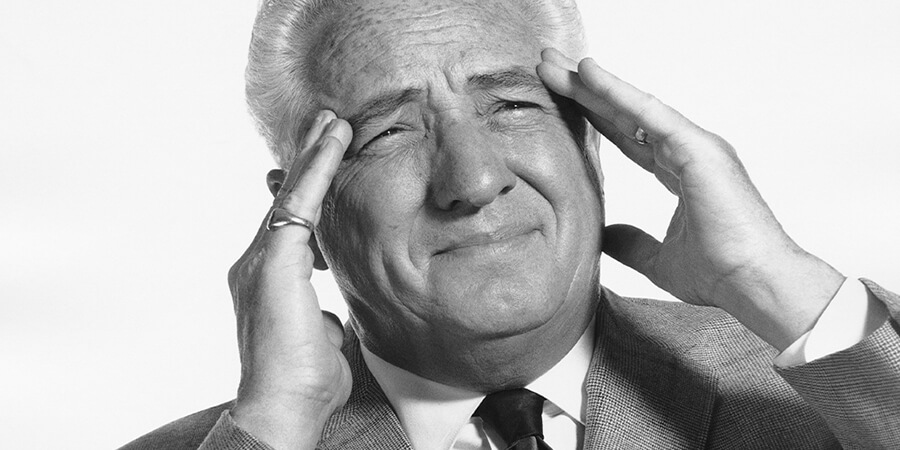4 Discovery Interview Errors that Frustrate Your Customers

Discovery interview errors are costly and unnecessary. Learn four blunders to avoid and improve your qualitative research.
With the New Product Blueprinting process, nothing is as powerful as the Discovery Interview. For innovation, for marketing, for strategy: the Discovery Interview stands alone. As structured qualitative research, it’s the best opportunity to gather customer needs. To hear their stories and process their pains. To open our minds to what our customers can teach us without the filter of our biases.
Poor interviews reveal little and frustrate the customer. A high performing team learns many things and along the way, they even build customer relationships. And so, here are four blunders to avoid. Let’s consider them so that we may never have to experience one in live action.
Discovery Interview Error #1: A non-moderator takes over the conversation
Let’s start with the biggest of them all: Someone other than the moderator takes control of the meeting. They ask questions without deferring to the moderator’s leadership. They probe as they like and ask questions as they like. When this happens, the session descends into confusion. The moderator is now in the difficult position of determining whether to wrestle for control or just abdicate his role. Neither is ideal. The moderator should at least make some attempt to assert control, but if the non-moderator doesn’t get the hint, the conversation will bounce around like a BB in a garage. Not only are we unlikely to learn many customer outcomes, but it produces a disjointed conversation and a stressed customer. This is one of the worst errors that a team member can make – if not the very worst.
How do we avoid this error?
Discuss roles prior to the interview. Reinforce the roles of moderator, note-taker and observer. Regarding the moderator, this person must establish and maintain control. It’s natural for a note-taker to probe for spelling. It’s natural for the observer to probe for clarification. But neither should change the topic. For non-moderators, your rule should be when in doubt about whether to speak, don’t. Watch your moderator for cues as to whether they are still probing, or have paused after a line of questioning.
Click here to obtain the Discovery Interview Research Report
Discovery Interview Error #2: We seek to demonstrate our knowledge
Customers may be impressed, but their feedback will be dampened. We will never know what they would have said otherwise. Serving up what we want to hear, our customers may try to avoid sounding stupid in front of such learned experts. Even worse, through the filter of our confirmation bias, we hear more of what we want to hear…. while learning nothing.
How do we avoid this?
We should remember that the customer is the expert – period. As a team, stay focused on learning – not informing. Speak as little as possible to avoid revealing your biases. Even manage your own body language, which might be perceived as judgmental by the customer.
Discovery Interview Error #3: Not allowing for silence
As the interviewing team, we want to feel that the interview is “going well.” And especially if just getting started with VoC work, we may be overly sensitive to this concern. After a good question, often the best thing that you can do is to be silent. Let the question hang out there. Give the customer an opportunity to process. Extroverted team members have a difficult time with this. Sorry to generalize, but often sales people attending interviews also have a difficult time with this. But if we are never silent, and we continually fill the air with our thoughts – we lose the opportunity to get beneath the surface. For this reason, suppress the need to hear yourself talk. Decide to let the conversation breathe, even if it feels uncomfortable.
How do we avoid this error?
Count to ten. Review your notes. Pretend to write something. Take whatever strategy you need, but resist filling the silence. It’s critical to discuss with your team, as it only takes one person to violate the silence.
Discovery Interview Error #4: Confusing solutions with outcomes
When asked “What problems do you have operating your factory?” A B2B customer may say that they want to “Track energy usage.” This is a legitimate customer need just as it is – to track energy usage. However, it’s also a solution – and more probing is probably in order. You need to understand the customer’s problem, and you’re probably not there yet. You might begin with “What problems would it solve if you could track energy usage?” They might say:
- We adjust our budget monthly, and I’d like feedback as soon as I can get it.
- A spike in energy usage gives us advanced warning when a major machine is about to fail.
- Our corporate headquarters has a new green initiative. We want to report back what percent of our energy is from green sources, such as our solar panels or reclaimed heat.
A solution can address many customer problems. If we don’t probe to them, we never get to the core issue. We may feel that it’s obvious, and that it makes us “look stupid” to ask “why” one more time. But that’s your own ego, afraid of not looking smart, that doesn’t want to ask once more.
How do we avoid this error during the Discovery Interview?
Don’t hesitate to ask again, “What would this help you to accomplish?” Throughout the interview, the customer will appreciate that you’re respecting them enough to not make assumptions – and to check with them to make sure that you really understand them. Also, consider using a VoC tool such as Blueprinter® software. That way, you’re keeping customer’s most recent comments front and center within the conversation.
Keeping the ego in check, respecting the customer as the expert, keeping product managers involved (if not leading) the experience, and meeting as an interviewing team to reinforce best practices will go a long way to avoiding these mistakes. A little training goes along way as well!
Also, keep in mind that the post-interview Debrief session should be not only about cleaning up the notes, but should also be about improving the team’s effectiveness. With each interview, strive for progress and excellence, not perfection. And remember that generally speaking, as long as we keep the customer talking within our project’s scope, that’s usually a sign of a good interview.
Finally, an understanding of jobs-to-be-done will ground you in the basics of what a customer can and cannot reliably tell you. This provides an extremely valuable perspective to avoid these blunders!



Comments